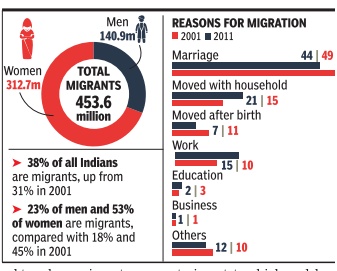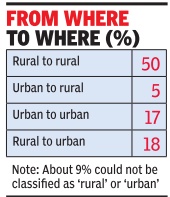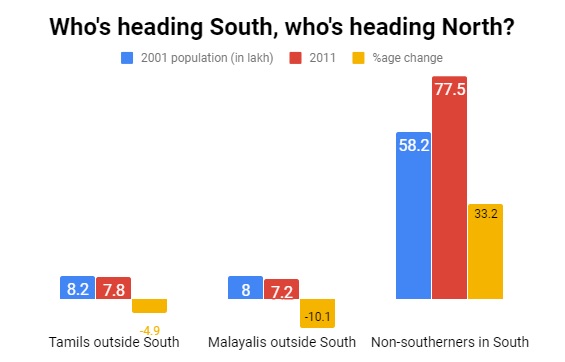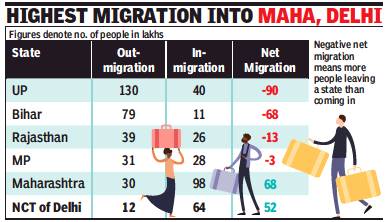Migration, internal: India
This is a collection of articles archived for the excellence of their content. |
Contents |
Internal migration
40% Indians migrants; mainly for marriage
Subodh Varma, 4 of 10 Indians migrants, most move for marriage, Dec 2, 2016: The Times of India


Nearly two out of five Indians -some 454 mil lion in all -are migrants, having left their place of residence and settled down somewhere else, according to fresh Census 2011 data on migration released on Thursday . Between 2001 and 2011, 139 million Indians migrated within the country . The vast majority of migrants, 69%, are women moving out of their parental homes to stay with their husbands in their native homes, or perhaps migrate with them elsewhere.
Half of this massive movement of humanity is taking place within rural areas -rural-to-rural migration.Rural-to-urban migration makes up about 18% while urban-to-urban is another 17%. In 2001, the share of ru ral-to-urban migrants was about 17%, indicating that there has not been a big shift in the percentage of people moving from villages to cities during the 2001-2011decade over the 1991-2001decade.
This complements the earlier data given by the census that the urban growth ra te is not too high and has slackened in many cities.
Among the reasons cited for migration by those surveyed, about 10% moved in search of employment during the decade ending 2011, down from 15% in 2001. This is counterintuiti ve, considering the po pular belief that mig ration is primarily driven by work.The share of those moving to pursue education makes up only 2% of migrants, down from 3% recorded in the 2001 census.
Marria ge remains the biggest cause for migration, accounting for 49%, up from 44% in 2001. The census questionnaire includes a reason de signated as “moved after birth“, which is mainly children being born in a pla ce -the mothers' village or a nearby town with hospital -and then moving back home to the parental ho use. This share has in 7% creased from in 2001 to 11%More in 2011.
than a fifth of all migrants had said in 2001 that the reason for migrating was that their fa mily was moving. They wo uld be dependents, both yo ung and old. This share has declined to 15% in 2011.
Hindi, Bengali, Odia speakers surge in South India/ 2011
Rema Nagarajan, June 28, 2018: The Times of India

Migration of non- southerners to south India.
From: Rema Nagarajan, June 28, 2018: The Times of India
HIGHLIGHTS
Just-released data from the 2011 census on mother tongues seems to indicate a reverse migration trend from earlier decades
Maharashtra, once a favoured destination for south Indians, mostly because of Mumbai, witnessed a decline in Kannada, Telugu, Tamil and Malayalam speakers
Tamil and speaking populations are falling across most states in north India even as and Kerala are seeing a huge jump in the number of Hindi, Bengali, Assamese and Odia speakers. Just-released data from the 2011 census on mother tongues seems to indicate a reverse migration trend from earlier decades when people from the two southern states migrated in large numbers to the north.
Instead, a large number of people from the two states are now migrating within the south, with Karnataka seeing a significant influx. Delhi saw a fall in numbers of both Tamil and Malyali speakers between the 2001 and 2011 censuses.
Maharashtra, once a favoured destination for south Indians, mostly because of Mumbai, witnessed a decline in Kannada, Telugu, Tamil and Malayalam speakers. In the north, the highest growth in Malayali population between the 2001 and 2011 censuses was in Uttar Pradesh, perhaps because of Noida, while that of the Tamilian population was in Haryana, which might be because of Gurgaon.
But the absolute numbers involved are small compared with the migration of Tamilians and Malayalis within south India. While Tamil Nadu and Kerala saw the highest growth in Hindi speakers among all states, all of south India is witnessing a steady increase, with the highest absolute number of Hindi speakers in the region being in Karnataka and Andhra Pradesh.
Kerala also saw the highest growth in Assamese and Bengalis even if the absolute numbers were not as high as in Maharashtra or Karnataka. The number of Nepali speakers too is growing fast in the south.In both cases, there is a growth of about 24% in populations speaking the respective languages.
Talent from north heads south
Recruitment agencies are facing a new challenge: While there are more job opportunities in the south thanks to a surge in startups, e-commerce and retail firms, the talent is in the north.
The south accounts for close to 40% of Randstad India’s recruitment for its clients, followed by the west at 28%, north at 25% and the east at 7%. For TeamLease Services, 40% of overall job positions are for the south. The figure would touch 70% if south and west are combined. Rituparna Chakraborty, co-founder, TeamLease Services, said: “People follow jobs and move where there is surplus demand for talent. At this point, that’s from north to south.”
Tally Solutions, a Bengaluru-based company that offers business management software solutions, has been recruiting from north India. Kankana Barua, chief people officer at Tally Solutions, said: “Companies facing a crunch in talent above mid-levels are looking for talent across India, especially from the north.”
The old reluctance to move to a city with a different language and cuisine is also eroding. Barua said that if a company provides good growth opportunities, people are ready to relocate. The influx of people from different regions to Hyderabad, Bengaluru and Chennai is creating cultural diversity. “I now see people conversing in Hindi in Chennai, for instance,” said Barua.
3 South IT hubs account for 60% of workforce
The south is home to three of India’s seven largest urban centres and accounts for more than half the total jobs created in the formal sector. The emergence of the IT industry as the single largest employer of graduates has played a significant role.
The three southern IT hubs of Chennai, Hyderabad and Bangalore account for more than 60% of the workforce employed by the sector, as per industry estimates. Chennai and Hyderabad are hubs for manufacturing and infrastructure too.
Paul Dupuis, MD and CEO, Randstad India, said: “The south will continue to lead the way in job creation, specifically in IT and related roles, given the headstart the region has in terms of the number of companies, presence of a qualified talent pool, quality educational institutions, and relative proximity of the three major urban centres.”
Naresh Rajendran, HR head, Grundfos India, which is headquartered in Chennai, said the company does not find it hard to hire talent willing to move to the south. He added that there is a trend of knowledge and blue-collar talent moving from other regions to the south, for IT, automotive, retail, e-commerce and infrastructure jobs.
2011-16
NEW DELHI: The Covid-19 pandemic may have brought the vulnerability of migrant workers into focus but data show more and more people have been moving from their native villages in search of work opportunities to other states over the decades. The magnitude of inter-state migration in India accelerated from five to six million annually between 2001-11 to nine million annually between 2011-16. Urban population in India grew from 286.1 million in 2001 to 377.1 million in 2011 which constitutes 31.14% of the total population residing in 53 urban agglomerations with more than a million people. Nearly 14% of this urban population was estimated to be living below the poverty line in 2011-12 with 65.5 million living in slums. India’s urban population is expected to rise to around 606 million by 2030. These figures are part of a comprehensive voluntary national review report on a wide range of sectors and progress made presented by Niti Aayog at the United Nations High-level Political Forum (HLPF) on sustainable development.
The report, Decade of Action: Taking SDGs from Global to Local, emphasises how India is focussing on making the Sustainable Development Goals (SDGs) monitoring and implementation more localised for better results. It maps India’s progress, challenges and the way forward on various SDG goals ranging from no poverty, zero hunger, good health and gender equality to sanitation, sustainable cities and reducing inequalities.
In the backdrop of the pandemic, Niti Aayog, vice chairman, Dr Rajiv Kumar, asserted that “the role of international cooperation is more critical than ever before.”
Despite the pressure on cities, the report says “migration can, in fact, be turned into a strong economic opportunity by overcoming bottlenecks such as migrants’ lack of access to healthcare, social entitlements, education for children, lack of improvement in skill profile and employability”.
A significant proportion of migrants and the poor in cities are employed in the informal economy which makes them vulnerable, especially in times such as the Covid-19 crisis. The report says that to mitigate the impact on various sectors including migrants both the central government and the states have announced an economic relief package with both short term and long term measures.
The report cites the importance of schemes like “One Nation, One Ration Card” for enabling access to subsidised foodgrains across the country, irrespective of the place of origin of migrants. It highlights the need for a database on migration and labour mobility to keep a tab on the current situation and take corrective measures.
Stakeholders feel labour welfare legislations which focus on safeguarding the livelihoods of those in the informal economy, require renewed impetus in urban centres.
Outward and inward migration
…in the bigger states/ 2011
July 20, 2019: The Times of India

From: July 20, 2019: The Times of India
More than 5.6 crore Indians lived in states other than the ones they were born in, newly released census data for 2011 shows. While UP, Bihar, Rajasthan and MP had the highest ‘out-migration’, Maharashtra, Delhi and Gujarat saw the largest ‘in-migration’.
Among larger states, Bihar had the lowest number of people migrating into the state with most of the 10 lakhplus migrants coming from Jharkhand and UP. In the case of UP, which had just over 40 lakh in-migrants compared to almost 1.3 crore out-migrants, a lot of the in-migration could also be due to people from all of India flocking to the NCR cities of Noida and Ghaziabad. In Haryana too, Gurgaon and Faridabad could account for a sizeable chunk of the 37 lakh in-migrants.
Though the thumb rule is that states with a high level of development have lesser outmigration than people flocking in, more people left Tamil Nadu and Andhra Pradesh than Bengal or Assam.
UP-born people constitute 45% of migrants to Capital: Data
Uttarakhand, Chhattisgarh and Jharkhand had more in-migration than out-migration. People born in UP constituted the largest chunk (45%) of Delhi’s migrant population followed by MP (41%), Maharashtra (31%), and Gujarat (24%). Contrary to the popular perception of Biharis moving in droves to Punjab, Haryana, Delhi or Mumbai, migrants from Bihar moved more towards the east. People born in Bihar constituted 62% of migrants in Jharkhand, 47% in West Bengal, 31% in Assam and other north-eastern states compared to just 18% in Delhi and 6% in Maharashtra.
In most southern states, people from neighbouring states constituted the bulk of the migrant population. In Kerala, Bengalis, who constituted 5% of the migrant population were the only significant nonsouthern chunk, with Tamils (53.2%) and Kannadigas (16.4%) being the most numerous among non-locals. Similarly, in Punjab, Himachal, Uttarakhand and Haryana, people from neighbouring states account for most of the migrant population, though natives of UP and Bihar, too, have a sizeable presence in these states.
Rajasthanis mostly moved to Gujarat, MP and Haryana. They, however, constitute the biggest chunk of those from the North (5%), among migrants in Tamil Nadu and other southern states like Andhra and Karnataka.